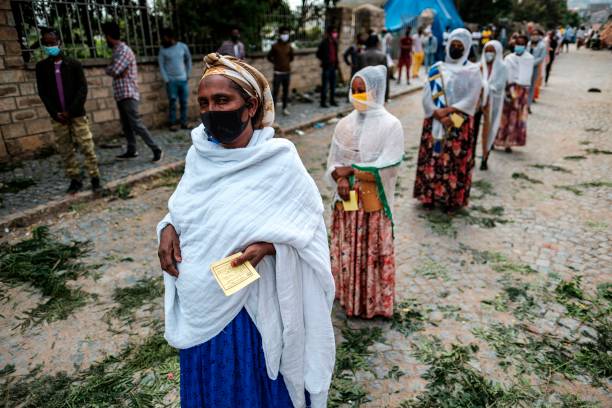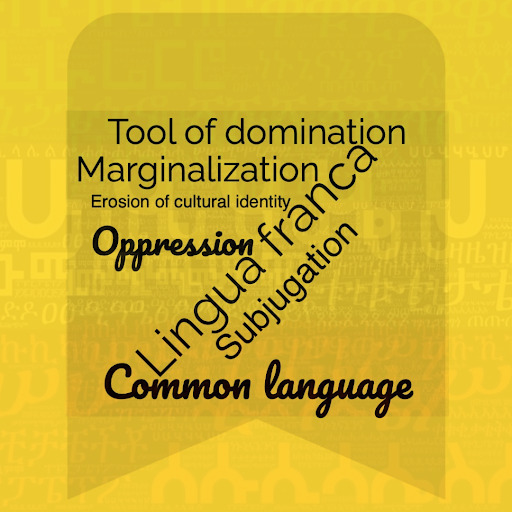Fleeing War – A Personal Experience



A lingua franca is a language which is commonly used by people with various mother tongues as means of communication. The relationship of Amharic to marginalized nations and nationalities in Ethiopia is one that parallels the language of colonizers in former colonies; a language enforced on a people as an instrument of domination. Thus, the role of Amharic as a lingua franca in the Orthodox Church, judiciary system, educational institutions, commerce, and military is emblematic of a larger problem with the nature of the Ethiopian empire state.
Attempting to create a nation out of an empire state, there has been a concerted effort to centralise power and create a national identity using force in Ethiopia – any subnational group to stand against this ideology was deemed an enemy of the state that must be forced to assimilate or be eliminated. As such, in a brutal nation building process across hundreds of years, anything that strayed from the Amharic speaking-Orthodox norm was seen as a direct threat to the cohesive ‘national identity.’
The establishment of Amharic as a lingua franca can be traced to the end of the 13th century, when King Yäkuno Amlak, a prince from Bete Amhara, overthrew the ruling Zagwe dynasty and restored what many in today’s Amhara region believe to be the Solomonic dynasty. Although depicted in the kebra negast “glory of the kings,” a 14th century written account that is considered to hold the genealogy of the Solomonic dynasty, King Yäkuno Amlak’s claim to originate from the Solomonic Dynasty is incorrect; it is a political fiction designed to legitimize Shewa-Amhara rule.
The Aksumite kingdom as the genuine beginning of the Solomonic dynasty is therefore delegitimized by the creation of a divine right of kings’ doctrine. Following King Yäkuno’s accession, Amharic was designated as the lәsanä nәgus “king’s language,” acting as the Ethiopian court’s spoken lingua franca.
King Teweodros II, who reigned from 1855 to 1868, was the first king of the Ethiopian empire to establish Amharic as the country’s literary language, ensuring that his royal chronicles were written in Amharic rather than Ge’ez, which previous rulers had done. His successor, Emperor Yohannes IV, although Tigrayan, used Amharic in his dealings with regional monarchs with the belief that Amharic would aid in the Ethiopian empire’s unification.
The subsequent reign of Emperor Menelik II was largely marked by the formation of modern day Finfinne, Addis Ababa, and the expansion of the Ethiopian empire to its current borders. Amharic-speaking officials administered the annexed territories in newly built towns, as a result Amharic was given a de-facto official status as the national lingua franca.
Although previous rulers advanced Amharic to varying degrees, Emperor Haile Selassie declared Amharic the official language of Ethiopia in 1955 as a ploy to unify nations and nationalities under one Ethiopian identity. Following the establishment of the printing press in the city of Dire Dawa and later in the capital city, Finfinne at the end of the 19th century, Amharic became the main language of printed materials like journals, novels, and books for educational purposes. Emperor Haile Selassie established a legal framework and policy to ease navigating the empire’s myriad of linguistic groups. While his predecessor focused on using Amharic as the mode of communication among elites, Emperor Haile Selassie targeted the general population; Amharic was the only language used in schools and government. Other languages and cultures, particularly Afan Oromo, were disregarded. Under Haile Selassie, Tigrigna was not considered its own language, rather a dialect of Amharic.
During its tenure from 1974 to 1991, the military junta, known as the Derg, modified the language policy; the linguistic rights of marginalized Ethiopian nationalities were formally recognised. Under the Derg, the policy of literacy included Amharic, Tigrigna, Afan Oromo, Somali and Afar. However, in reality Amharic remained the main administrative language. Amharic remained the only official language and medium of teaching in primary school. Between 1974 and 1984, the number of elementary schools more than doubled, accelerating the development of Amharic and its usage in inter-ethnic dialogue.
The doctrine behind the policy to enforce Amharic in the social and political sphere intends to create a homogenous state with the Amharic language at the center as a symbol of unity and tool of forced assimilation.
The change in the status of Amharic as the national language of Ethiopia was only in 1991, when the Ethiopian People’s Revolutionary Democratic Front (EPRDF) formed a coalition government and introduced a multinational federalist system, giving all Ethiopian languages equal influence. Article 5 of the constitution outlined that all Ethiopian languages should enjoy equal recognition although Amharic shall be the working language of the federal government. Despite EPRDF’s efforts to encourage nations and nationalities to instate their own languages in federal states and districts, Amharic remained the country’s de facto lingua franca, given how widespread it had become prior to the appointment of the coalition government.
The role of Amharic in the social and political sphere is an extension of Amhara domination in Ethiopian history and culture. Thus, the brutality used to enforce Amharic as a lingua franca is part of a coordinated effort to erase or hijack the multinational history and contribution of various ethnic groups in Ethiopia, much like King Yäkuno Amlak’s claim to be from the Solomonic dynasty.
The formation of modern-day Ethiopia during Emperor Menelik II’s reign used violence to destroy the autonomy of nations and nationalities in order to assimilate to a distorted Ethiopian identity. The legacy of an inherently imperialist empire, combined with attempts of numerous leaders to differentiate Amharic from other Ethiopian languages has resulted in the Amhara hegemony that subsequently birthed several liberation fronts and arguably the fragmentation still seen in present day Ethiopia.
Rowena Kahsay – Omna Tigray Contributor, January 2022